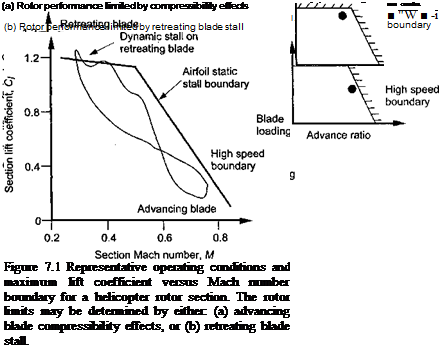Helicopter Rotor Airfoil Requirements
A representative variation in the operating lift coefficient, Q, versus incident Mach number, M, for a section near the tip of a helicopter rotor blade in forward flight is illustrated in Fig. 7.1. Two flight conditions are shown. Superimposed on each figure is the approximate static stall boundary for a first-generation airfoil, such as the NACA 0012. One condition is where the rotor operational limits are determined by advancing blade compressibility effects. The other condition is where the rotor limits are determined by retreating blade stall. Notice that in either case the advancing blade operates at low AoA but at high subsonic or transonic conditions, whereas the retreating blade operates at low Mach numbers and high lift coefficients. Overall, it will be seen that this airfoil section operates throughout at a condition close to the boundary where flow separation may occur. Because the onset of flow separation may ultimately limit rotor performance, there has been a great deal of emphasis in rotor design on maximizing the lifting capability of rotor airfoil sections to
 |
simultaneously alleviate both compressibility effects and retreating blade stall. The rotor design point, therefore, must recognize the influence of both effects as limiting factors, as well as allow sufficient margin from the stall/compressibiiity boundary for perturbations in AoA and Mach number associated with maneuvering flight and turbulent air.
The general requirements for a good helicopter rotor airfoil are as follows: [24] [25]
4.
 |
A low pitching moment. This will help minimize blade torsion moments, minimize vibrations, and keep control loads to reasonable values.
In airfoil design, it turns out that many of these requirements are conflicting in that they cannot all be simultaneously achieved with the use of a single airfoil shape. However, much can be done to maximize one or more of the airfoil performance attributes without drastically compromising another. To do this, however, requires an understanding of the key (and interrelated) effects of factors such as airfoil shape, AoA, Reynolds number, and Mach number on the aerodynamic performance.














